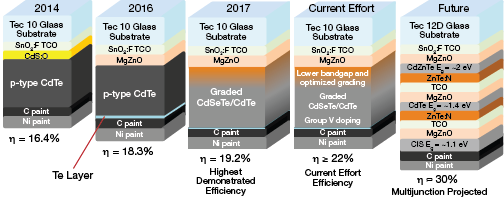Center for Next Generation Photovoltaics (NGPV)
June 17, 2020
Sensing and Information Systems
Energy sustainability represents one of the grand challenges facing modern society, and thin-film solar photovoltaics provide one of the best opportunities for rapidly expanding renewable energy use. Photovoltaics (PV) using the thin-film semiconductor cadmium telluride (CdTe) have been commercialized at the gigawatts (GW)-per-year scale, with 17.5 GWs installed globally.
In many utility-scale applications, it is less expensive to generate electricity using CdTe PV than fossil fuels. The levelized cost of energy (LCOE) from CdTe PV is ~$0.04/kWh, while the national average LCOE from all sources is $0.11/kWh. Furthermore, the lifecycle emissions of the heavy metal Cd from CdTe PV are lower than those from traditional electricity generation for the same amount of energy generated. CdTe uses approximately one one-hundredth the amount of semiconductor materials used for c-silicon PV (the most common PV in use today) and can be processed 24 times faster than c-silicon.

</a>
To further reduce the cost of electricity from CdTe PV, Colorado State Univ. (CSU) researchers and partners at the Center for Next Generation Photovoltaics, an Industry-University Cooperative Research Center funded by the National Science Foundation, developed a performance roadmap (Figure 1). Progress since 2014 has been marked by three advances to the basic cell structure of CdTe PV. The progress was possible thanks to advanced device processing capabilities developed at CSU combined with state-of-the-art materials characterization by its partners.
The first advance was the replacement of the traditional CdS emitter layer with magnesium-doped zinc oxide (MZO). MZO has a higher bandgap that allows more photons to reach the CdTe absorber. In addition, MZO has conduction-band offset that helps reduce interfacial recombination, thereby preserving the voltage.
A second improvement in 2016 was the incorporation of a Te layer at the back of (below) the CdTe, which yielded an improved contact and higher efficiency. These improvements allowed the CSU PV’s efficiency to reach 18.3% (independently certified) in 2016.
The largest breakthrough, however, was the introduction of an alloy layer of CdTe and CdSe (CdSeTe) in front of the CdTe. One advantage of the CdSeTe layer is its smaller bandgap, which enables it to produce more current. More importantly, however, it has a much longer recombination lifetime than CdTe, and it appears to form an electric field in the favorable direction at the transition to CdTe. These characteristics together have moved the cell voltage about 80 mV closer to the bandgap, and efficiency at CSU labs (without an antireflective [AR] coating) reached 19.2% in 2017.
In addition to the high cell efficiencies, the CSU team has built CdTe structures to lay the foundation for the next performance breakthrough. For example, the structures have achieved lifetimes of photogenerated electrons above 1,000 nanoseconds, compared to <10 nanoseconds in most CdTe cells. In addition, CSU’s structures demonstrate interfacial recombination velocities less than 80 cm/sec, compared to typical values above 104 cm/sec. Concurrently, partners at Washington State Univ. and the National Renewable Energy Laboratory have achieved doping levels for holes in CdTe above 1016 cm–3, which is much greater than the typical mid-1014 cm–3 range.
These achievements pave a clear path toward even higher cell efficiencies, and make 25% a realistic near-term (3-year) goal and 30% a reachable long-term goal. The efficiency gains will lead to lower LCOE from CdTe PV. In addition, the research at CSU is performed on pilot-scale systems, which can be readily translated to industrial manufacturing.
“The researchers at CSU maintain a close coupling between laboratory research and what is commercially impactful,” says Markus Gloeckler, Chief Scientist at First Solar. First Solar is the largest manufacturer of CdTe PV modules.
This work was primarily funded through support from the Industry-University Cooperative Research Center (IUCRC) Program and the NSF Partnerships for Innovation (PFI) program.
This article was prepared by NSF for AIChE and appeared in the March 2018 issue of Chemical Engineering Progress.
